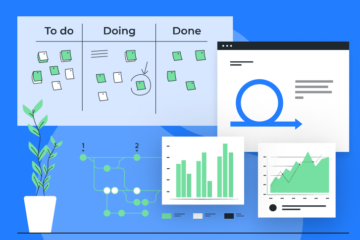Secrets Behind Building a Productive Software Development Team

Structuring your software development team is critical for the successful completion of any project you embark upon. If you have faced any problems figuring out what makes up for a good team, here are some bulletproof ways to maximize the efficiency and productivity of your team.
Define the Team Goals
Teams are created to serve certain purposes, such as particular projects where a team is dissolved once the project ends, or they can be a core unit for ongoing projects. In addition, the projects may be short-term or long-term, influencing the overall team efforts. The goals you set mainly determine the requirements for your software development team. Whether it is the support of the existing software, the new launch, internal/external projects or something else, these factors highly influence the demands set for a team in terms of expertise, members and experience. As every goal is different in terms of demands, you need to create a team that functions effectively and helps you to achieve the desired results.
Choose the Development Methodology
Once you have decided on your goals, the next step would be to choose the development methodology to bring more structure to your processes and optimize team performance. There are a lot of different methodologies, and it may be hard to choose the best one for your projects, as all of them are designed with specific requirements in mind. However, we will try to simplify the work and summarize the most popular approaches to software development:
Agile
This is considered to be one of the most popular development methods because it takes into account all the circumstances which can change the scope of the project. It also supports quick adjustment to plans made beforehand, allowing more flexibility and relevance regarding the end product. Here are frameworks based on the Agile methodology:
- Scrum. This framework focuses on delivering results in iterations called sprints. It allows you to break down bigger projects into smaller deliverables and monitor team velocity. Based on that, you can provide better estimations on the scope of the project. It also includes compulsory events called ceremonies, such as planning, retrospective, sprint reviews, and daily syncs.
- Kanban. Created to make planning more transparent, Kanban allows you to visualize all the tasks on a physical or virtual board and see their progress at once to determine what resources you possess and what priorities your team has. In turn, it facilitates processing urgent tasks and planning ahead so the dependencies between the team members are minimized.
- Extreme programming. This is another Agile framework focused on user-stories (describing the required feature on the basis of how users will be able to interact with them and their main aims). It includes the main three components: respect, simplicity of the code and communication. As one of the Agile frameworks, it is also based on delivering results in sprints.
Waterfall
Nowadays, more and more teams refuse this methodology because of the lack of flexibility, but it still can be used for bigger teams and companies. In its core, there is thorough planning before the start of the project and the cascade scheme of performing the tasks. It means that the next steps are blockers for the previous ones. Only if you finish with the first step can you go to the second, and then once the second is done, the third one may begin, and so on. While it makes the process longer than if the steps were done in parallel, there is a good chance you will see the project overview from the beginning until its end.
Rational Unified Process Methodology
This methodology also enables the precise planning and structuring of the work. It divides any project into four stages: inception, when you start working on the project; elaboration, where the research is done; construction of the software; and then transition, meaning the software is released for its target audience.
Spiral
As it may be understood from the very name, the work in Spiral methodology presumes that every development step is a loop in a spiral and their number varies depending on the project. During each stage, you need to address the following issues to be able to go further: think over the solutions and its alternatives, perform the risk assessment, develop the planned solution and review the achieved results to proceed to the next spiral loop where the process is repeated until the project ends.
Rapid Application Development
This one may come in handy if you have a team of experienced engineers and need to release the software in a limited time period. After the project scope discussion, special attention is paid for building models and prototypes and then on the basis of the feedback, the prototypes are turned into fully-fledged functional released after performing a solid amount of testing.
Feature-driven development
In this methodology, the development is divided into different iterations based on the feature completeness. It means that once you build a general overview and create the requirements, you proceed to planning, designing and building software by its certain features. When all of them are done and put into the monolith system, the project is considered complete.
Depending on the project requirements, you may see that some of the frameworks will definitely not work for your team and choose the proper methodology based on your resources and needs.
Decide on the Team Structure and Roles
When the goals and methodologies are defined, it is time to think over the members. Depending on the methodology chosen, they may vary and include some specific roles (such as Sсrum Master or Product Owner if you opt for the Scrum methodology), but the main roles would be the following:
- Software Architects build the architecture of the software and make strategic technology decisions related to the software the company is building.
- Software Developers specialize in certain technologies required by the product.
- Project Managers take part in the management over the project and lead communication between the team and stakeholders, defining the budget and ensuring that the team meets all the deadlines.
- Tech Leads have advanced knowledge in a given technology and are responsible for the performance of the developers.
- QA engineers perform various testing of the product to ensure the end result corresponds to all the requirements and has no flows in the functionality.
- UI/UX designers are responsible for the visual appearance of the application and for the interface design.
Some teams also include SEO specialists responsible for promoting web applications on the internet, as well as content managers and marketing representatives, but in bigger companies, these positions exist on the company level and are not considered to be a part of the development team.
Choose the Optimal Team Size
Most software development organizations still believe the more people they throw into a project, the better the result will be. Unfortunately, this, which may seem to be a very simple and straightforward way, is not how software development works. Of course, there are large projects that require enormous numbers of human hours to complete, but a larger workforce rarely translates to better results. In fact, small teams are often more efficient than large ones. Therefore, sometimes less is more. You may check the results on the average team size for different global companies below:

While the recommended team size in Agile should not exceed nine people, there are still some arguments among the experts regarding the ideal number of team members. Taking into account this factor, if you have a big team, it is recommended you split it into smaller groups from five to nine members. Doing so will allow you to have a better overview of team performance and ensure that all the Agile principles are met.
There is no perfect number of people that would be universal and suit all the software development teams, and you’ll have to determine your perfect team size yourself through your joint highs and lows. Amazon’s Jeff Bezos says that you can feed a perfect software team with two pizzas, which makes up to 15 people maximum. Considering how reasonable this is in practice, there’s actually a good point in it: The more people who are involved, the harder it becomes for them to communicate. Eventually, miscommunication or lack of information from someone’s side leads to delays in the progress, which affects the entire project.
Takeaway: Make sure the size of your development team allows for efficient communication. A team of five to nine people might be your target. This approximate number of people will have no problem communicating with each other, which will translate into decent efficiency and productivity.
Desired Software Team Type Must Be Defined
Depending on what kind of project you work on, you must assemble a team that consists of people with specific skills to fill the talent gap for successful project completion. There exist different approaches to defining the teams. For instance, there may be functional teams (i.e., marketing or development) where all the people are grouped to perform the same function and report to their team managers of the same unit, as well as cross-functional teams consisting of people taken from different departments to fulfill their roles, which also considers the project they are working on. One more approach used in Agile is based on the team members’ roles, meaning you can form one of the three major types of software teams: Specialist, Generalist, or Hybrid.
Specialists
Specialists, as you might have already guessed, are highly skilled professionals who know their job description well enough to perform the assigned tasks with no extra micromanagement or frequent errors. Having these members in your software organization is always great because they usually do their work flawlessly while sticking to the set guidelines and timeframes.
The downside of the Specialist type of teams is that their area of expertise is quite narrow. They work by the book and rarely deviate from the ordinary course, so you can assign them to specific tasks only. In addition, hiring experts can cost you a fortune since they are true gurus in their field.
Generalists
The Generalist group implies the type of employees that are also great for software engineering teams because they can complete almost any task you assign to them. Generalists are flexible and able to learn quickly to prepare for almost any challenge. This type of team gives you an opportunity to experiment with your approaches while getting things done according to the schedule.
But there is a different side of Generalists to keep in mind. Do you know what they say about jacks of all trades? They are masters of none. These guys are always good but rarely great, so you can end up neglecting the quality of work with this kind of team.
Hybrid
Obviously, a Hybrid team implies that you have both Specialists who focus on what they’re most qualified in and Generalists who can perform a wide scope of tasks. This kind of organization in a product development team structure gives you the best of both worlds. You can throw a couple of Generalists and Specialists in and get the combination of flexibility and precision, varying the number of each type of employee.
Which to Choose?
The decision on which of the three team types, Specialists, Generalists or Hybrids, would be the best fit for you must be made depending on what software product development team structure suits your interests in the first place. If your goal is a short-term project you’ll finish in a couple of weeks in order to move on to the next one immediately, then the Generalist team is your best choice because of the small but specific workload. If you are up to some serious long-term project, then it is best to employ more specialists to divide the workload into numerous smaller and diverse tasks. In this case, your employees will do the job with precision while having a longer period of time to complete the project.
If it is something in between that you need, then you should consider a hybrid software development team structure.
The Importance of Communication and Documenting Processes
Nowadays, communication plays a crucial part in every field, and development teams are not an exception. Your task is to foster it, engaging all your team members into some group and individual discussions. When people have an opportunity to share their feedback and concerns regarding certain decisions and projects, they can address them on the spot and avoid situations when some potential unpleasant issues remain unnoticed, resulting in the scope of the project suffering. Moreover, proper communication facilitates the relationships on the team and helps to achieve higher results.
Though it might sound like a monotonous and tiresome job, you need to keep track of all steps in the course of project completion. First of all, you need to define your objectives to set clear goals according to who owns software developed for your company. This will help move toward and think about people you might want to have in your team. Create a software development organizational chart and include the specialists you want to see on your team, assigning a detailed profile of both their professional and personal traits. Maybe there already are some people you know or used to work with in your application development organizational structure, so you might want to contact them first since it is always better to work with someone you’re confident in because of your experience or some trusted positive recommendations.
Then, after you came up with the software development organizational chart you think will work best for you, try to document the following:
- Your software development team roles and responsibilities;
- Goals of your application development team;
- Resources your team will need to function properly;
- Obstacles you might face along the way;
- Development of the procedures aimed at routine task facilitation.
Providing the answers to these points at the beginning is not enough; you should better document all these throughout the project to see whether your plans need any adjustment and then change the points as you progress.
Stages of Working in a Software Development Team
In any software development organizational structure, the teams of developers go through a number of stages. A widely accepted model on the stages of team performance was developed by the American psychologist Bruce Tuckman. You can read more about it in this article. According to this theory, there are five major stages in the functioning of each team, regardless of the field or industry where they operate, which includes software development:
- Forming. At this stage, you, as a leader, start assembling the team. You plan its functioning, create your software development organization chart and divide the roles and responsibilities of your team members. Finally, you gather them all in one room.
- Storming. Storming is the stage in team formation at which the majority of trouble begins. After the excitement of meeting the new team, the members start to compete and expose their strengths and weaknesses. Some of the examples of where conflict can occur are the brainstorming and decision-making processes. This is when team members will most likely be overconfident in their opinions, neglecting those of the rest of the team. The aim is to normalize the situation and avoid conflict because some of them will try to challenge your authority, some will provoke their colleagues, and some will just show little to no respect to you and others.
- Norming. This one is the stage at which people start to work in a more or less efficient manner. If you survived the storming stage, then you are up for some productive work from here on out. It’s the transition to the quiet period of your collaboration.
- Performing. It is where your team works together as a real, disciplined and self-organized entity. They will help each other and perform to show the best of their abilities with the intention to produce the desired outcome.
- Adjourning. This is sometimes the saddest stage because it is when the team finishes the project and no longer needs to exist. Thank all of your colleagues for the hard work and excellent performance they have shown and wish them good luck in their future careers. If you’re lucky enough, they will do the same for you.
Conduct Regular Performance Checks
If you already created a team, went through all the stages of functioning and have shown steady progress, it does not mean the work is done. In order to ensure high performance and optimal results, it is crucial that apart from the prior planning and retrospectives after the end of a certain project or iteration, separate meetings dedicated to the team performance have been conducted. The aim of these meetings is to discuss the triumphs and failures of the team, the reasons for сertain outcomes, and praise the team for the achieved results. Such meetings help teams to evolve, create a team spirit and learn to share the responsibility for their actions among all the team members without blaming or praising individuals. This also encourages honest and direct feedback. Last, but not least, such group discussions also allow members to raise important questions and resolve complicated issues, eliminate conflicts and enable the team to operate as an integral unit.
Wrap-Up
As you can see, there are some important aspects of software development team formation to consider when wondering how to run a successful software product team. Among such, you have to choose the right size of the team to ensure excellent communication, define the type of subordinates you want to have on your team, document all of that, realize the stages that your team will go through and establish yourself as the team's leader to guide it in the right direction. Overall, creating a good team is a challenge, but keeping the listed points in mind and using them in practice should simplify the task for you.





Comments (7)